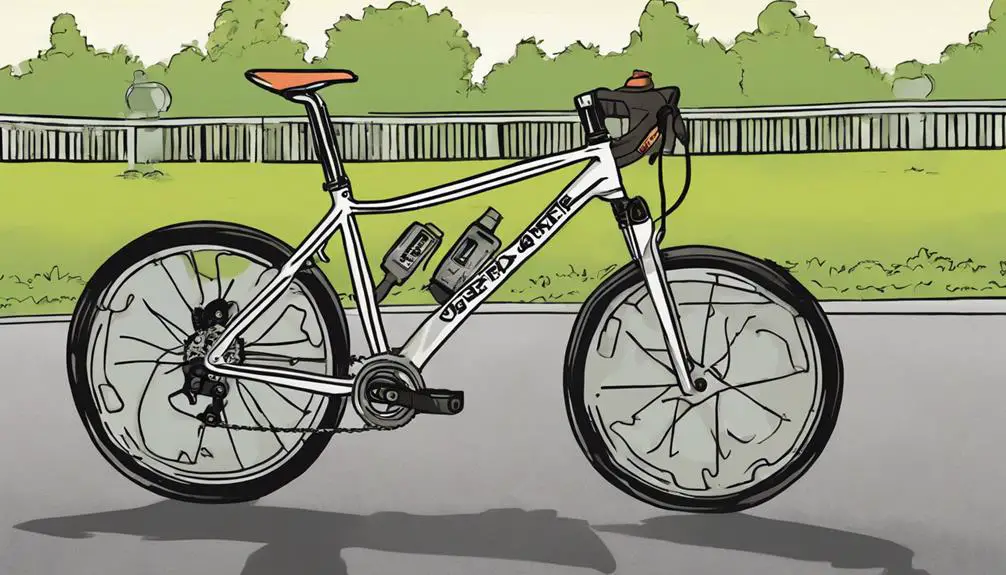Imagine a tightrope walker balancing high above the ground; even the slightest miscalculation can lead to disaster. Similarly, when it comes to bikes, understanding rider weight limits is essential for safety and performance. These limits aren't just numbers; they're the result of careful engineering and design considerations. You might think you can push the boundaries, but what happens when you exceed them? Let's explore the factors that determine these limits and how you can guarantee your ride remains both safe and enjoyable.
Quick Takeaways
- Consult the manufacturer's owner's manual for specific weight limits for riders, passengers, and cargo for optimal safety and performance.
- Calculate total load capacity by combining rider weight and all additional gear to ensure it stays within the specified weight limit.
- Understand that exceeding weight limits can compromise bike handling, stability, and structural integrity, increasing the risk of accidents.
- Regularly check and maintain bike components like tire pressure and brakes to enhance performance and safety while adhering to weight limits.
Understanding Weight Limits

Understanding weight limits is fundamental for guaranteeing your bike performs safely and efficiently under your specific riding conditions. Each bike comes with its own set of specifications, and knowing these helps you access the full potential of your ride.
When you exceed the recommended weight limit, you risk compromising your bike's handling, stability, and durability. This can lead to a less enjoyable experience and even dangerous situations.
To determine your bike's weight limit, check the manufacturer's guidelines. These typically account for both the rider and additional gear. Remember, it's not just about you; the gear you carry plays an important role too.
If you're planning longer rides or carrying extra equipment, factor that into your calculations. A lighter bike often means a more liberated ride, allowing you to navigate trails and roads with ease.
Importance of Rider Weight
Rider weight plays a vital role in both safety and performance when it comes to biking.
If you exceed the recommended weight limits, you might compromise the bike's stability and handling.
Understanding how your weight affects these factors can help you make informed choices for a safer ride.
Safety Considerations
When selecting a bike, it's important to evaluate how weight affects safety and performance. Keeping within the manufacturer's recommended weight limits isn't just a guideline; it's a vital safety measure. If you ride above the weight limit, you could compromise the bike's structural integrity, increasing the risk of accidents. Your safety deserves priority, and understanding these limits helps you ride with confidence.
Riding a bike that can't support your weight can lead to mechanical failures. Think about it: a snapped frame or malfunctioning brakes can turn a leisurely ride into a dangerous situation. You want to feel the wind in your hair, not worry about your bike's ability to keep you safe.
Moreover, your gear plays a role too. If you're carrying extra weight beyond your limits—whether it's gear or supplies—it can affect how your bike handles. By respecting these safety considerations, you're not just ensuring your own well-being; you're embracing the freedom of riding without fear.
Performance Impact
How does your weight influence the performance of your bike? It's an essential factor that can determine how well you ride. When you hop on your bike, your weight directly affects acceleration, speed, and handling.
If you're lighter, you'll likely experience quicker acceleration and easier climbing, allowing you to conquer hills with freedom and finesse. On the flip side, if you're heavier, your bike may feel more stable and controlled, especially at high speeds, but you might find it takes more effort to get moving.
Your weight can also impact your bike's components. For instance, a heavier rider may put more stress on the frame and wheels, which could lead to wear and tear over time. Understanding this balance helps you choose the right bike for your needs, ensuring you feel empowered rather than constrained.
Ultimately, finding the right weight limit for your bike isn't just about safety; it's about optimizing your ride. Choose wisely, and you'll reveal the full potential of your biking experience, enjoying every twist and turn on your journey toward liberation.
Suzuki Motorcycle Specifications

When considering a Suzuki motorcycle, you need to pay attention to the manufacturer weight guidelines.
These specifications are essential for your safety and guarantee that your bike operates within compliance standards.
Understanding these points will help you make informed decisions about your ride and keep it performing at its best.
Manufacturer Weight Guidelines
Following Suzuki's specifications, understanding their weight guidelines is vital for guaranteeing safe and ideal performance on your motorcycle.
Suzuki provides detailed weight limits for each model, which include the combined weight of the rider, passenger, and any cargo. These guidelines help you maintain optimal handling and stability, allowing you to savor the freedom of the open road without compromise.
When you check the owner's manual or the manufacturer's website, you'll find these specifications clearly outlined. Pay close attention to the Gross Vehicle Weight Rating (GVWR) and the Maximum Load Capacity. These figures are essential because exceeding them can lead to performance issues or even accidents.
Safety Considerations and Compliance
Staying within Suzuki's weight limits not only guarantees compliance with safety standards but also enhances your riding experience by maintaining ideal handling and control. When you respect these specifications, you're not just following rules; you're revealing the full potential of your ride. A bike that's overloaded can compromise stability, braking, and overall performance.
It's essential to check the owner's manual for the specific weight limits. These guidelines are rooted in rigorous testing and engineering, aimed at keeping you safe while you conquer the open road. If you exceed these limits, you risk more than just compliance violations—you risk your freedom to ride safely.
Factors Affecting Weight Limits
Several factors influence the weight limits of bikes, including frame material, design, and intended use.
When you think about the frame, consider how different materials like aluminum, carbon fiber, or steel can support various weights. Aluminum is lightweight yet strong, while carbon fiber offers high strength-to-weight ratios, making it ideal for performance bikes.
Next, the bike's design plays a significant role. A well-engineered frame distributes weight evenly, enhancing stability and comfort. If you're riding a mountain bike designed for rugged terrains, its structure will support heavier loads compared to a sleek road bike built for speed.
Lastly, intended use is key. If you're using your bike for commuting or leisure, it might have a different weight capacity than one designed for extreme biking or touring. Each bike is crafted with a specific purpose in mind, so understanding that can help you gauge its limits.
Calculating Total Load Capacity

To determine the total load capacity of your bike, you need to reflect on both the manufacturer's specified weight limit and the combined weight of you and any additional gear or accessories.
Start by checking the bike's manual or the manufacturer's website for the weight limit. This figure is vital, as it reflects the maximum safe load your bike can handle.
Next, weigh yourself and any items you plan to carry, such as bags, tools, or camping gear. It's important to take into account everything—your weight, clothing, and even the water bottle in your cage. Add these weights together to find your total load.
Once you have this number, subtract it from the manufacturer's weight limit. If the result is positive, you're within safe limits. If it's negative, it's time to lighten your load.
Common Suzuki Models and Limits
When considering bike load limits, it's important to look at specific Suzuki models and their respective weight capacities. Each model has its own specifications, and knowing them can empower your riding experience.
Here are a few common Suzuki models and their weight limits:
- Suzuki V-Strom 650: This versatile adventure bike typically supports a maximum load of around 440 lbs, making it perfect for long journeys.
- Suzuki GSX-R750: A performance machine, it generally accommodates a combined weight of about 400 lbs, ideal for spirited rides on the track.
Understanding these limits helps you customize your bike for your needs, whether you're hitting the trails, the track, or cruising down the highway.
It's all about liberating your spirit while ensuring your bike performs at its best. By respecting your Suzuki's weight limits, you're not just protecting your ride; you're enhancing your journey, allowing you to focus on the thrill of the ride ahead.
Enjoy the freedom that comes with knowing your bike inside and out!
Safety Considerations for Riders

Understanding safety considerations is essential for guaranteeing a secure and enjoyable riding experience. When you're out on the open road, your focus should be on the freedom of the ride, not on potential risks.
First, always check your bike's weight limits. Exceeding these can compromise handling and increase the risk of accidents.
Next, wear appropriate protective gear. A good helmet, gloves, and sturdy riding boots can make a world of difference in an unexpected situation. You want to feel liberated, not constrained by fear.
Pay attention to your body position and grip on the handlebars. A balanced posture enhances control, allowing you to respond swiftly to any hazards. If you're carrying extra gear, verify it's securely fastened and evenly distributed; this keeps your bike stable.
Lastly, always be aware of road conditions and other traffic. Your awareness can be the difference between a carefree ride and a dangerous situation.
Maintenance for Optimal Performance
Regular maintenance is essential for keeping your bike performing at its best and guaranteeing a smooth, safe ride. When you take the time to care for your bike, you're not just preserving its longevity; you're also enhancing your freedom on the road.
Here are three key areas to focus on:
- Tire Pressure: Check your tire pressure regularly to guarantee maximum grip and handling.
- Brakes: Inspect and replace brake pads as needed to maintain stopping power.
Neglecting these aspects can lead to poor performance and even safety hazards. By committing to regular checks and minor repairs, you'll experience the true liberation that comes from a well-functioning bike.
Remember, your ride is an extension of your adventurous spirit, so treat it with the care it deserves. Embrace the journey, and let your bike be the vehicle of your freedom!
Common Questions
Can Rider Weight Limits Vary Between Bike Models?
Absolutely, rider weight limits can vary between bike models. Each bike's design, materials, and intended use influence its weight capacity.
You'll find that mountain bikes, road bikes, and hybrids all have different specifications. It's crucial to check the manufacturer's guidelines for each model.
How Do Accessories Impact the Total Weight Limit?
Accessories can greatly influence your bike's total weight limit. When you add items like racks, bags, or child seats, you're increasing the overall load.
It's crucial to take into account both your weight and the weight of these accessories to guarantee safe riding. You want to enjoy your freedom on two wheels, so check your bike's specifications and account for any gear you plan to use.
Balancing this will keep your rides both enjoyable and safe.
Are There Weight Limit Differences for Electric Bikes?
When you're soaring on an electric bike, you might wonder if those weight limits are different.
They often are! Electric bikes typically have higher weight limits due to their robust frames and powerful motors.
But remember, just like a bird needs strong wings to fly, your bike's performance depends on staying within its recommended weight range.
What Happens if I Exceed the Weight Limit?
If you exceed the weight limit, you might compromise your bike's performance and safety.
You could experience issues like reduced handling, increased wear on components, or even potential damage.
Your ride might feel unstable, and braking could become less effective, putting you at risk.
It's crucial to respect these limits to enjoy a smooth, liberating ride.
Staying within the guidelines lets you embrace the freedom of cycling without concerns.
Do Rider Weight Limits Apply to Passengers as Well?
Yes, rider weight limits typically apply to passengers too.
If you're planning to take someone along for a ride, it's essential to take into account their weight in addition to your own.
Ignoring these limits can compromise safety and performance.
You want to enjoy your ride without worries, so make sure both you and your passenger fit within those guidelines.
Freedom on the road is best experienced when you're aware of your bike's capabilities!
Wrapping Up
In summary, knowing your bike's weight limit is essential for safe riding, especially since about 30% of motorcycle accidents involve issues related to load capacity.
By factoring in your weight, gear, and any passengers, you can guarantee a smooth and stable ride.
Always check your manufacturer's specifications and regularly maintain your bike to enhance performance and safety.
Remember, staying within weight limits not only protects you but also extends your bike's longevity.
Ride safe!